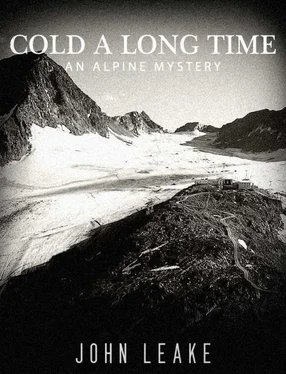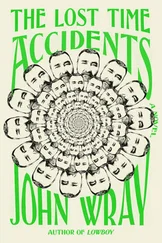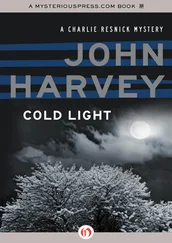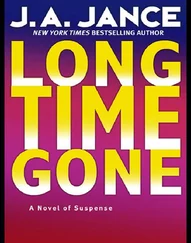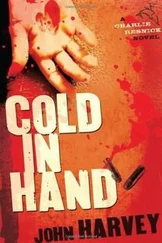A couple of days after the Canadian searchers began their misguided hunt, Lynda and Bob drove into Neustift to do some errands. The Stubai Valley was especially glorious that day. Its meadows were dusted with the first snow; its larches had turned a brilliant yellow, contrasting with the dark green spruces, covering the hillsides with a lovely patchwork. As they headed back to the Mutterbergalm, it began to snow. They understood that if it continued, it would force the Canadians to end their search.
“I don’t want to be here to see them pack up,” Bob said. “It’s just too depressing.” And so they decided that if the snowfall didn’t abate soon, they would go ahead and return to Saskatoon.
The Canadians searchers didn’t find Duncan, and as it continued to snow, they announced they were ending the search and would return home on October 15. Lynda and Bob decided to depart the day before. After they loaded their car, Lynda took a final look at the snow-covered mountains. It was, she thought, a cold place to spend the winter. Well Duncan , she said, we’ve done everything we can to find you, but we haven’t given up. We’ll be back when the snow melts.
As they headed out of the valley, steadily increasing their distance from the Mutterbergalm, Lynda had the terrible feeling that she was leaving her child behind. Bob drove in silence, feeling, she knew, exactly the same. For two months they’d tried so hard to find him, or at least his body, and now they were going back to Saskatoon empty-handed. It was almost unbearable.
Chapter 8: The Hut Manager’s Story
When Lynda was eighteen she fell in love with a boy named Bill who worked for Saskatchewan Power. A year into their relationship, she felt she would be happy spending the rest of her life with him. One summer Friday they made plans to drive up to Candle Lake for the weekend, as soon as he got off work. That afternoon, with a happy feeling of anticipation, she baked a walnut chiffon cake for the outing, but just as she was pulling it out of the oven, she felt suddenly terrible and dropped it to the floor. Just after 5:00, her brother, who also worked for SaskPower, walked into the house with an expression of dread on his face.
“What?” she said.
“Bill was killed this afternoon by a high power line.” Later she learned that he’d been electrocuted at 3:00—just as she’d suddenly felt so unwell. For a long time she grieved and felt disoriented. Her father and brother couldn’t stand to see her crying.
“Don’t cry, Lynda,” they always said, distressed by her tears, but at a loss for what to tell her. And so she learned to cry only when she was by herself. After about two years, her pain began to diminish, ultimately becoming an occasional sadness instead of a constant hurt (though for the rest of her life she would never again bake a walnut chiffon cake).
She knew well, then, the succession of feelings that such a loss sets in motion. First, there was the shock verging on disbelief, then the anger and depression, and then finally a gradual acceptance and recovery. Terrible as Bill’s death had been, it didn’t compare to Duncan’s disappearance, because as long as Lynda didn’t have her son’s body or at least proof of his death, the train of grief couldn’t leave the station. Instead she was stranded in an emotional no-man’s land of confusion, fear, and restlessness.
Sometimes she wondered if there was any way that it was all just a bad dream—that Duncan would one day show up with a wild story of where he’d been. It was heartbreaking to see his dog Jake, every day sitting by the front window, watching. He rarely got excited about men approaching on foot, as he seemed to recognize that they weren’t Duncan, but each time he saw a boy in the neighborhood going by on a bicycle, he barked and wagged his tail enthusiastically, apparently thinking it was his master, riding home from hockey practice.
For months after their return to Saskatoon, they received no update and no record of the investigation from the police. It appeared that no information, possible leads or witnesses—nothing that could be useful for a subsequent search—were documented, which meant that if they wanted to follow up, they would have to rely on their own notes. The Austrian and Canadian authorities were apparently of the attitude that they “should get on with their lives,” as Consul Thomson had advised them.
Needless to say, they weren’t ready to do that, as there was still far too much ambiguity surrounding their son’s disappearance. While Lynda was in Stubai, she discovered that as long as she was working to find him, she could keep the helpless, empty feeling at bay. Back in Saskatoon, waiting to hear from the police, she felt it creeping in, like the cold into a poorly insulated room.
She knew that he was probably dead, but there was no way she could give up looking so long as there was even a slight chance he was still alive. What if he was confined somewhere by an abductor? To cease looking for him seemed like abandoning him, which was unspeakable. She imagined him stuck in a bad place and desperate for his parents to find him. Don’t give up mom , she imagined him saying, and she knew that if it had been the way around, he would have never have given up trying to find her.
When they finally did get an update, it wasn’t from the police, but from Angelika Ladner. She’d heard from the manager of the Bremer Hut, who’d seen a missing person poster in Innsbruck on October 10 and noticed that the young man in the photo resembled a foreigner who’d appeared at the hut around midnight on September 25. His arrival had been alarming because he’d come from the Nuernberger Hut that night—a very dangerous trek in the dark without a flashlight. He didn’t even have a backpack, just a sports bag slung over his shoulder. Unkempt, he acted strangely, as if disoriented.
The next morning he ate a big breakfast and then set off towards the Laponesalm Hut, whose manager (the son of the Bremer Hut manager) also saw him. There he made a call to Augsburg, Germany from the pay phone, spoke to someone in English, and produced a large wad of schillings to pay for it. He then set off again, but because it was foggy, he quickly vanished from sight. From the Laponesalm he could have taken a path down to the Gschnitz Valley or an unmarked smugglers’ trail into Italy.
Lynda was astonished to hear the story, and wondered why the hut manager hadn’t reported it earlier. A disoriented, English-speaking foreigner appeared at the same time the largest manhunt in the history of the Stubai Alps was underway for a missing Canadian . The gendarmerie had called the huts on September 21, and by September 25, everyone in the valley knew about the search for Duncan. That the hut managers were unaware of him until October 10 seemed incredible. Are these people trying to drive me insane? Lynda wondered.
That the young man had seemed disoriented reminded her of the theory that Duncan was suffering from the aftereffects of Lyme disease. He’d never been forgetful, so it wasn’t like him to have left his leather jacket at Roger Kortko’s house and his clothing in Walter Hinterhoelzl’s office. Could he have been the foreigner who’d wandered off from the Laponesalm and vanished into the fog?
The hut manager’s story indicated that the young man had been improperly equipped, inexperienced, and confused, which put him at high risk for a mountain accident. The implication was that he’d either died in the Stubai Alps or wandered into Italy. Lynda didn’t know what to do with the story other than report it to External Affairs and request that it be forwarded to the police, though she doubted they would investigate it. Judging by their silence, they had already closed Duncan’s case.
Читать дальше
